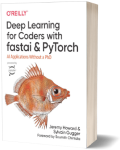Deep Learning for Coders With Fastai and Pytorch
Artificial Intelligence
Book Details
Book Title
Deep Learning for Coders With Fastai and Pytorch: Ai Applications Without a Phd
Author
Jeremy Howard, Sylvain Gugger
Publisher
Oreilly & Associates Inc
Publication Date
2020
ISBN
9781492045526
Number of Pages
1109
Language
English
Format
File Size
10.3 MB
Subject
Deep Learning
Table of Contents
- Preface
- Foreword
- Part I. Deep Learning in Practice
- Chapter 1. Your Deep Learning Journey
- Deep Learning Is for Everyone
- Neural Networks: A Brief History
- Who We Are
- How to Learn Deep Learning
- The Software: PyTorch, fastai, and Jupyter (And Why It Doesn’t Matter)
- Your First Model
- Deep Learning Is Not Just for Image Classification
- Validation Sets and Test Sets
- A Choose Your Own Adventure Moment
- Questionnaire
- Chapter 2. From Model to Production
- The Practice of Deep Learning
- Gathering Data
- From Data to DataLoaders
- Training Your Model, and Using It to Clean Your Data
- Turning Your Model into an Online Application
- How to Avoid Disaster
- Get Writing!
- Questionnaire
- Chapter 3. Data Ethics
- Key Examples for Data Ethics
- Integrating Machine Learning with Product Design
- Topics in Data Ethics
- Identifying and Addressing Ethical Issues
- Role of Policy
- Conclusion
- Questionnaire
- Deep Learning in Practice: That’s a Wrap!
- Part II. Understanding fastai’s Applications
- Chapter 4. Under the Hood: Training a Digit Classifier
- Pixels: The Foundations of Computer Vision
- First Try: Pixel Similarity
- Computing Metrics Using Broadcasting
- Stochastic Gradient Descent
- The MNIST Loss Function
- Putting It All Together
- Adding a Nonlinearity
- Jargon Recap
- Questionnaire
- Chapter 5. Image Classification
- From Dogs and Cats to Pet Breeds
- Presizing
- Cross-Entropy Loss
- Model Interpretation
- Improving Our Model
- Conclusion
- Questionnaire
- Chapter 6. Other Computer Vision Problems
- Multi-Label Classification
- Regression
- Conclusion
- Questionnaire
- Chapter 7. Training a State-of-the-Art Model
- Imagenette
- Normalization
- Progressive Resizing
- Test Time Augmentation
- Mixup
- Label Smoothing
- Conclusion
- Questionnaire
- Chapter 8. Collaborative Filtering Deep Dive
- A First Look at the Data
- Learning the Latent Factors
- Creating the DataLoaders
- Collaborative Filtering from Scratch
- Interpreting Embeddings and Biases
- Bootstrapping a Collaborative Filtering Model
- Deep Learning for Collaborative Filtering
- Conclusion
- Questionnaire
- Chapter 9. Tabular Modeling Deep Dive
- Categorical Embeddings
- Beyond Deep Learning
- The Dataset
- Decision Trees
- Random Forests
- Model Interpretation
- Extrapolation and Neural Networks
- Ensembling
- Conclusion
- Questionnaire
- Chapter 10. NLP Deep Dive: RNNs
- Text Preprocessing
- Training a Text Classifier
- Disinformation and Language Models
- Conclusion
- Questionnaire
- Chapter 11. Data Munging with fastai’s Mid-Level API
- Going Deeper into fastai’s Layered API
- TfmdLists and Datasets: Transformed Collections
- Applying the Mid-Level Data API: SiamesePair
- Conclusion
- Questionnaire
- Understanding fastai’s Applications: Wrap Up
- Part III. Foundations of Deep Learning
- Chapter 12. A Language Model from Scratch
- The Data
- Our First Language Model from Scratch
- Improving the RNN
- Multilayer RNNs
- LSTM
- Regularizing an LSTM
- Conclusion
- Questionnaire
- Chapter 13. Convolutional Neural Networks
- The Magic of Convolutions
- Our First Convolutional Neural Network
- Color Images
- Improving Training Stability
- Conclusion
- Questionnaire
- Chapter 14. ResNets
- Going Back to Imagenette
- Building a Modern CNN: ResNet
- Conclusion
- Questionnaire
- Chapter 15. Application Architectures Deep Dive
- Computer Vision
- Natural Language Processing
- Tabular
- Conclusion
- Questionnaire
- Chapter 16. The Training Process
- Establishing a Baseline
- A Generic Optimizer
- Momentum
- RMSProp
- Adam
- Decoupled Weight Decay
- Callbacks
- Conclusion
- Questionnaire
- Foundations of Deep Learning: Wrap Up
- Part IV. Deep Learning from Scratch
- Chapter 17. A Neural Net from the Foundations
- Building a Neural Net Layer from Scratch
- The Forward and Backward Passes
- Conclusion
- Questionnaire
- Chapter 18. CNN Interpretation with CAM
- CAM and Hooks
- Gradient CAM
- Conclusion
- Questionnaire
- Chapter 19. A fastai Learner from Scratch
- Data
- Module and Parameter
- Loss
- Learner
- Conclusion
- Questionnaire
- Chapter 20. Concluding Thoughts
- Appendices
- A. Creating a Blog
- B. Data Project Checklist
- Index
